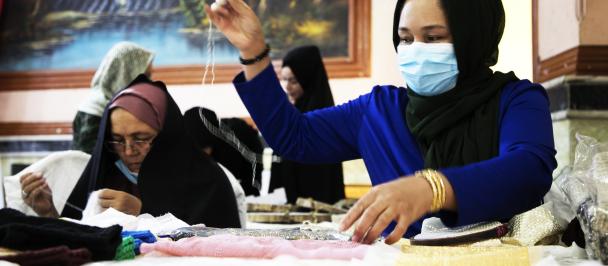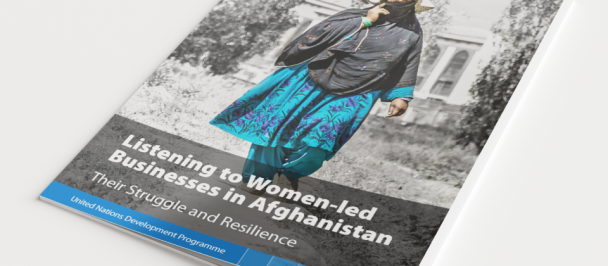Despite some improvements in economic indicators in 2022, growth remains below the levels required to break the poverty trap. Decisions restricting women’s education and work threaten a reduction in aid with grave consequences
UNDP warns that restrictions on women’s rights will worsen economic catastrophe in Afghanistan
April 18, 2023
A new study of Afghanistan’s economy demonstrates that without continuity for girls’ education and women’s ability to work, prospects for the country’s recovery will remain grim.
The study, “Afghanistan Socio-Economic Outlook 2023”, released today in Kabul by the United Nations Development Programme (UNDP), details how Afghanistan’s economic output collapsed by 20.7 percent following the Taliban takeover in 2021. This unparalleled shock has kept Afghanistan among the poorest countries in the world.
And despite tentative signs of recovery, such as a relatively stable exchange rate, an increase in exports, growing demand for labor, and muted inflation, GDP is estimated to have further declined by 3.6 percent in 2022.
“A sustained inflow of foreign aid, to the tune of $3.7 billion in 2022, has helped avert the total collapse of Afghanistan,” said UNDP Resident Representative in Afghanistan Abdallah Al Dardari.
The United Nations (UN) contributed $3.2 billion of the overall $3.7 billion in foreign aid to Afghanistan in 2022. UN assistance reached directly 26.1 million Afghans with some form of aid, while helping to stabilize the exchange rate, curb inflation and affect other economic indicators.
The new report projects that the 2023 GDP in Afghanistan could increase by 1.3 percent if the level of foreign aid remains at $3.7 billion. However, prospects for economic recovery remain weak and insufficient over the long term, especially if foreign aid is withheld as a result of restrictive Taliban policies.
“There will be no sustainable recovery without the active participation of Afghan women in the economy and in public life, which includes delivering on humanitarian and livelihoods-saving projects,” said UNDP Regional Director for Asia and the Pacific, Kanni Wignaraja. “Only the full continuity of girls’ education and women’s ability to pursue work and learning can keep the hope of any real progress alive.”
The edicts restricting the rights of women and girls, including a directive banning Afghan women from working for the UN, directly affect economic productivity and may also impact the level of aid inflows. There are also considerable headwinds arising from adverse geopolitical factors and economic difficulties in the neighboring countries, which could spill over to Afghanistan.
The new UNDP paper analyzes the potential impact of a hypothetical aid cut on Afghanistan’s economy. Using an indicative value of a 30 percent reduction in aid from $3.7 billion to $2.6 billion, UNDP projects that Afghanistan’s GDP would further contract by 0.4 percent, a decline that would send the country hurtling to the bottom of the global poverty scale.
The study notes that impoverished Afghans are already taking extreme measures to survive. “Some have been compelled to sell their homes, land, or assets that generate income; others have resorted to the distressing practice of commodifying their own family members, turning children into laborers and young daughters into brides,” the report states.
“Afghanistan is on the brink of economic collapse, exacerbated with the takeover in August 2021. The effects of the pandemic, followed by an extraordinary 20.7 percent contraction of the economy, and an unusually severe drought, have resulted in the loss of food, livelihoods and access to basic services,” said UNDP Administrator Achim Steiner in a statement. “Only the continued provision of international aid and basic services to millions of Afghans have prevented a full collapse.”
The research finds that the number of people living in poverty skyrocketed from 19 million in 2020 to 34 million in 2022. “If foreign aid is reduced this year, Afghanistan may fall from the cliff edge into the abyss,” Al Dardari cautioned.
For more information and to arrange interviews, contact:
Stanislav Saling, Communications Specialist, UNDP Asia-Pacific, stanislav.saling@undp.org, +1 347 653 1980
Robert Few, Chief of Communications, UNDP Afghanistan, robert.few@undp.org, +44 7947 710 860
Farhad Zalmai, Partnerships and Communications Associate, UNDP Afghanistan, farhad.zalmai@undp.org, +93 790 509 133
Note to editors
Main findings of the 'Afghanistan socio-economic outlook 2023'
The economic situation continues to spiral. GDP is estimated to have further declined by 3.6 percent in 2022 after the 20.7 contraction in 2021. With a population estimated by the UN at about 40 million and GDP of $14.3 billion in 2021, Afghanistan is among the countries with the lowest per capita income in the world.
There are signs of recovery: a rise in exports; an expected increase in domestic fiscal revenue by 8 percent; stabilization of the exchange rate; and a reduction in inflation – all undergirded by substantial international assistance of $3.7 billion in 2022, of which $3.2 billion was provided by the UN.
However, recovery is weak and in the long term insufficient. In a baseline scenario developed by UNDP, GDP is projected to increase by 1.3 percent in 2023, and 0.4 percent in 2024. Both are well below the population growth rate that exceeds 2 percent, implying that per capita incomes will keep declining.
There are considerable headwinds arising from adverse geopolitical factors and economic difficulties in the neighboring countries, which could spill over to Afghanistan in the form of repatriating nationals, imported inflation for staples such as food and fuel, and heightened security risks.
UNDP simulations suggest that if aid were to drop by 30 percent, GDP could contract by 0.4 percent in 2023 and inflation rate might reach about 10 percent in 2024. By that time, per capita incomes could decline to a projected $306 compared to $512 in 2020 – a drop of 40 percent.
The level of foreign aid provided in 2023 will be a key determinant of Afghanistan’s economic outlook and the scale of response to its humanitarian crisis. The WoAA2022 survey results suggest that the per capita expenditures of around 85 percent of the population are below the 2020 poverty line.
At face value, this suggests that the number of poor has increased to 34 million in 2022 (from 19 million, using 2020 data) while the funding requirements for Afghans today to maintain their expenditures at the 2020 level may have reached $5.3 billion (nearly 35 percent of current GDP) from $900 million (5 percent of GDP two years ago). The UN aid appeal for international assistance to reach $4.6 billion in 2023 is therefore the minimum required to help Afghans in need.
Any reduction in international aid will worsen the economic prospects of Afghanistan and extreme poverty will perpetuate for decades. But the economy cannot be reignited if women cannot work, while future economic growth is constrained by underinvestment in girls’ and women’s education.

 Locations
Locations


